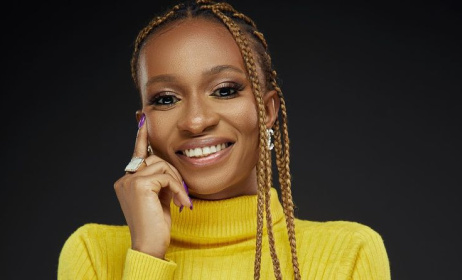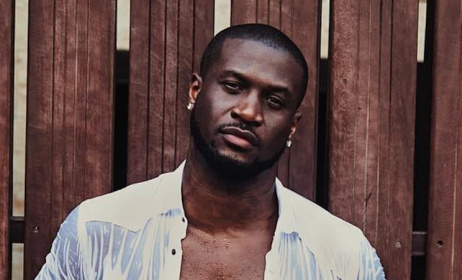Popular music in Nigeria
By Ed Keazor
Popular music in Nigeria can be divided into three general time periods: the Traditional period (early times till mid-19th century); the Post-Western Influence period (mid-19th century till 1960); and the contemporary Popular music (1960 till present). 2face Idibia is one of the most respected pop artists in Nigeria
2face Idibia is one of the most respected pop artists in Nigeria Wande Coal
Wande Coal
Traditional period
Nigeria is a diverse cosmopolitan nation with over 250 ethnic groups with largely distinct languages which influence individual musical styles. Music was employed in Traditional societies for communal celebrations/social events, religious/ritual purposes and leisure/ entertainment. The various forms of traditional music served as the popular music of early times.
The common instrumental voice employed by all ethnic groups was and is the leather skinned traditional drum. In Western Nigeria, there is the ‘Gangan’ (talking drum), the Bata, the massive Gbedu and Sakara drums. In Northern Nigeria, the Kalangu (talking drum), the Tambari (kettle drum) and others. In Eastern Nigeria, the mighty Ikoro drum, the medium-sized Igba drum and the hollow clay bass pot (‘Udu’). Many of these named drums were eponymous with the styles of music and dance they represented, e.g Kalangu music, Ikoro music and dance, the Bata dance and the Igba dance. Melodic instruments were employed alongside rhythmic instruments such as Ogene or Agogo (gongs), Ekpili or Shekere (shakers), the Ubo (Thumb Piano), Oja (traditional flute) and the elephant tusk trumpet, Kuntigi (traditional guitar), Goje (traditional harp) and trumpet (Kakaaki).
Post-Western Influence
In the mid-19th century, the Anglican Church established several Churches around the country which employed congregational hymns in worship. The hymns became popular musical themes in Nigerian society especially when Priest Josiah Ransome-Kuti (Grandfather of Fela Kuti) began to compose hymns in Yoruba language. He was invited to London in 1922 to record an album because of the popularity. Two streams of popular music, based on social status, existed at this time. Choral Music and Classical music became the favourite of wealthy, educated Nigerians in the late 19th and early 20th century. For the less wealthy, traditional music remained favourite. This changed with the advent of Brass Bands. Originally of the colonial police and army, they gained cross-over appeal when they adapted traditional tunes, exposing them to a larger audience. Civilian Brass Bands were soon formed, the most popular was the Calabar Brass Band (aka Lagos Mozart Orchestra).
Popular music history was made in 1925 when the first Nigerian popular music recordings were made separately by two Nigerians: Ladipo Solanke, lawyer and political activist, and Domingo Justus, an Afro-Brazilian. Both recorded albums of Yoruba folk songs.
One of the earliest and most revolutionary forms of popular music which cut across ethnic boundaries was palmwine guitar music. A fusion of Latin and Caribbean music with African traditional vocals which emerged in the 1920s, it spread across southern Nigeria with early stars like Irewolede Denge, Ayinde Bakare, The Three Night Wizards, Tunde King and later Julius Araba. Palmwine Music, however, occupied a lower social status, being the preference of the working class. At the time, the waltz, foxtrot and other dances were introduced into Nigeria by the colonials, with musical accompaniment by big band ensembles (mostly drawn from army and police personnel). These became the preserve of the high society. Later, the fusion of Palmwine Guitar and big band music gave rise to highlife music.
Highlife Music was the musical lingua franca of Anglophone West Africa from the 1940s onwards. In Nigeria a plethora of stars emerged: Bobby Benson, Ishola Willie Payne, E.C Arinze, Bala Miller, Victor Olaiya, Fatai Rolling Dollar etc. This coincided with the establishment of Phillips West Africa Records, Lagos, which began releasing albums from local artistes in the 1930s. This and the establishment of the Lagos rediffusion Service (the radio service) served to bring Highlife and other forms of popular music to a wider audience.
Other forms of popular music in this era include: rock and roll, soul, R&B and jazz, imports from the USA. Significantly, the first Nigerian to record a jazz album, August Agboola Browne, recorded in Poland in 1928. Jazz was a dominant musical force in the 1950s, with stars like Chris Ajilo (who recorded the first afrobeat track in the period), bassist Steve Rhodes, drummer Bayo Martins, trumpeters Mike Falana and a young Fela Kuti.
Contemporary Popular Music
This period witnessed the search for an indigenous musical identity, with highlife continuing its trajectory. A number of other indigenous styles formed:
Juju Music: This evolved in the 1930s as a fusion of palmwine guitar music and traditional Yoruba music and was the sound of urban western Nigeria. Stars emerged, such as Tunde Nightingale, S.F. Olowokere, I.K Dairo, Kayode Fashola etc. The most prominent were King Sunny Ade and Ebenezer Obey. Others include Shina Peters, Segun Adewale etc.
Afrobeat: The first Afrobeat track, ‘Ariwo’, was recorded by saxophonist Chris Ajilo in 1961. The genre was popularised by Fela Kuti with a series of ground-breaking releases from 1960 till his death in 1997. This brought him and the genre international acclaim. Fela’s contemporary Orlando Julius later enjoyed sustained international acclaim. Fela’s sons, Femi and Seun Kuti carry his legacy with individual imprints. Others include keyboardist and band-leader Dele Sosimi and vocalist Ade Bantu.
Afrofunk: The fusion of American funk with African rhythms and vocals, which emerged in the late 1960s, peaked in the late 1970s, with a renaissance in the late 1990s. The Strangers, Wrinkars Experience, Monomono, BLO, The Funkees and Boy Band Ofege were among the proponents. Included are jazz funk stars like keyboardist Gboyega Adelaja and percussionist Aleke Kanonu.
Fuji Music: Fuji Music is an indigenous hybrid of Traditional Yoruba Music and Islamic chant, which had existed in previous forms as apala and sakara music. Fuji Music emerged in the 1970s with Sikiru Ayinde Barrister and Kollington Ayinla, and a female artist Salawa Abeni. Other artists emerged in the 1980s and 1990s, such as Obesere and King Wasiu Ayinde Marshall, the latter is one of the biggest ever stars of any genre in Nigeria. Wasiu Alabi Pasuma followed.
Foreign Imports
Asides the indigenous hybrids, mainstream genres like reggae showed strongly between the 1970s and 1990s with artists like Cloud 7, Sunny Okosuns, Ras Kimono, Evi Edna Ogholi, Majek Fashek, Mandators, Tera Kota gaining international prominence. The advent of dancehall and ragga, saw the emergence of more contemporary stars like General Pype, Felix Duke, Kupa Victory, Burna Boy and Pato Ranking. However the most successful in this category would be the multiple award-winning 2Face Idibia, whose catalogue straddles several genres.
Nigeria has produced a long line of soul, pop and R&B acts influenced by American and some European superstars. These included 1970s artists Joe Nez, Segun Bucknor, Bongos Ikwue and Akeeb Kareem; 1980s heartthrobs, Kris Okotie, Jide Obi, Dizzy K Falola, Adu Deme and Mike Okri; as well female singers Mary Afi Usuah (who sang on Italian Spaghetti Westerns soundtracks in the 1960s) Onyeka Onwenu, Christie Essien, Funmi Davies.
In the new millennium, a new generation of stars emerged: D’Banj, Darey, Banky W, Asa, Sound Sultan, P-Square, Wande Coal, Flavour, Davido, WizKid, Bez, Tiwa Savage, Omawumi, Waje etc.
Rap/Hip-hop
The biggest musical phenomenon of the new millennium was Nigerian hip-hop, which became an international brand. It started in 1981 with an experimental recording by Radio Jockey Ron Ekundayo, followed by the first hip-hop album released in 1988 by Sound on Sound, consisting of Americans Scratch, Mr Kool and Jedi and Nigerian singers Ebony Olaoye and Monica Omorodion. The 1990s saw the emergence of a home-grown brand, consisting of rap in ‘Pidgin English’, with the two pioneers being the groups Emphasis and the duo Junior and Pretty in 1991. From this spawned a revolution that exploded in the new millennium, with a succession of artists such as the group Remedies, Trybesmen and Maintain, and solo artists Eldee, Olu Maintain, Tony Tetuila and Eedris Abdulkareem. Later came Jazzman Olofin, Ikechukwu, Naeto C, Sasha P, Sauce Kid, Ice Prince, M.I, Jesse Jagz, Ill Bliss. Most of the early artists were on Obi Asika’s Storm Records.
The new millennium saw artists expressing their art in local languages, using indigenous genres, such as highlife and even decale. These included Lord of Ajasa, Mr Raw, MC Loph, DaGrin, 9ice and notable new sensations Olamide, Phyno and Reminisce.
Behind the sound of the millennium
A number of people are behind Nigeria’s new popular music paradigm. The first, DJs, are the silent heroes of Nigerian Hip-hop. DJ Jimmy Jatt was responsible for scouting some of the earliest Hip-hop talent in Nigeria for pioneer labels. DJ Howie Tee famously discovered P-Square. Producers are another group that have defined the new Nigerian sound, with some releasing albums. They include Don Jazzy, WizBoy, OJB Jezreel, Omololu, Sarz, Sheyi Akerele, the legendary Beatz duo of Ozezi and Okiemute Oniko, and Doyinsola Adeshola.
References
- Asika, Obi. 'Nigerian Soft Power'. Presentation at '90 years of Nigerian Popular Music', a Music In Africa event
- Ikonne, Uchenna . Nigerian Popular Music in the 1980s. Presentation at '90 years of Nigerian Popular Music', a Music In Africa event
- Idonije, Benson. 'Nigerian Popular Music 1930-1960s'. Presentation at '90 years of Nigerian Popular Music', a Music In Africa event
- Keazor, Ed. 'The Nigerian Afro-Funk Chronicles'.
- Ikonne, Uchenna 'Nigerian Rap (The first decade 1981-1991)'
- Keazor, Ed. 'The History of Nigerian Jazz'
























Commentaires
s'identifier or register to post comments